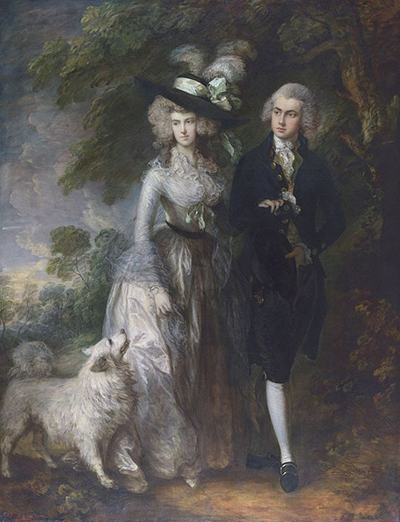Mr and Mrs William Hallet (The Morning Walk) was painted by Thomas Gainsborough in 1785 shortly before their marriage. Gainsborough painted this piece in London during the last years of his life. This piece demonstrates the leaps and bounds the artist had taken in his art.
This painting depicts a couple of high societal standing taking a stroll through the country side. The couple are arm in arms as they stroll with their dog. The couple's attention seems to be drawn to something in the distance off the right, while the dog stares enthusiastically at them. The man is dressed in a black suit and white stockings, while the lady is wearing a fine ivory silk dress with a black hat, which has a white bow and some feathers. The artist uses slanting brushstrokes, which seems to suggest movement and a light breeze. The extravagant costumes imply that the couple are of high social standing and wealthy.
The painting with its subtle poetic quality and feathery brushwork suggests that Gainsborough took inspiration from earlier master painters such as Anthony van Dyck and Jean-Antoine Watteau. The painting can be considered as a depiction of romance, high breeding, youthful elegance and also as a likeness study of Mr and Mrs William Hallet. It is believed that William commissioned and paid for this piece. The man in the painting, William Hallet, was brought up by his wealthy grandfather. Following the death of his grandfather in 1781, he inherited his estate. William travelled on the Grand Tour in Europe for 2 years before returning to marry Miss Elizabeth Stephen in 1785. Their extravagant wedding took place at the St Lawrence Church.
Elizabeth Stephen is believed to have been the child of a wealthy surgeon who passed away before she got married. While the theme of this picture may have been about romance, William was more preoccupied with betting and gambling, which would ultimately lead to his downfall. William made some disastrous dealings, which meant he had nothing of his fortune left by 1830. Elizabeth had 2 sons and 4 daughters. She died aged 69 and was buried in the same church where she got married. William married again and put up the painting of him and his first wife for sale at the Forster's sale room. However, it did not sell. He bestowed the painting to his daughter Lettice Elizabeth.




